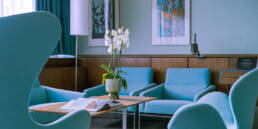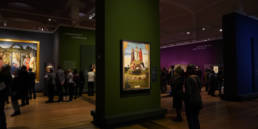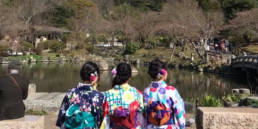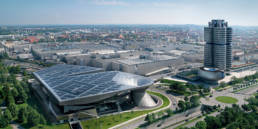When a friend wrote me on WhatsApp saying “when will you come visit me in Chartres?” I thought “why not?” and booked a low-cost flight from Pisa to Orly, an hour away from the French town known for its great Gothic Cathedral.

Chartres Cathedral has been a pilgrimage destination since the 12th century; perched upon a hill, you can see it for two of the five-day walk from the French capital. For me, Chartres has always represented a beacon of art history. As a child, I loved art, and on our family’s summer trips – often in France thanks to my Francophile mom – I would make itineraries to see museums and churches that I’d read about in art history books. My favourite cathedral, aesthetically, has always been Reims. But Chartes is where I had something of an epiphany. There’s an Englishman here named Malcolm Miller who came over as a volunteer guide in 1958 and stayed, making himself the greatest expert in the iconography of the cathedral’s windows and sculptures. When I was about 13 years old, we did one of his regular group tours. He reads one or two windows to you, looking at the iconography and connections between stories and figures in depth, and that was when I realized that art history was really a thing, a potential career; that there was years’ worth of interesting research to be conducted in just one image. This encounter, this cathedral, was instrumental in my decision to study art history. Would a return 30 years later be a disappointment, or would I love this place as much as before?
I had two full days in Chartres, staying and cooking with my friend Jonell, author of The Rambling Epicure (she’s an expert in French food with a love of Italy too), dipping into the cathedral numerous times (it’s free!) and walking around to some of the other sites. We were blessed by cool weather after the heatwave earlier this summer, and the temperature and clear skies made everything just marvelous. In short, I loved it.
Here’s a small itinerary of what to see in Chartres.
Chartres Cathedral: building as book
I’m not going to pretend that I’m an expert on Chartres Cathedral. It’s been a long time since I’ve studied French Gothic architecture, though I know the basic tenets – they built high and perforated the masonry with always-larger and more elaborate stained glass windows, built for the glory of God and containing visual stories for man to read.
Thanks to the presence of an important relic of the Virgin, Chartres became a centre of pilgrimage as well one of the top religious schools on the continent. The growing crowds required larger and larger buildings – the current Cathedral is the fifth iteration, while fires took down the earlier ones. The crypt that one can still visit is the foundation of the version from 1020-24, destroyed by fire in 1194. The west facade dates to 1150 and the rest of the present cathedral from 1195 to 1220. Most of the windows are from around this date, though they worked bottom up, and there are some chapels with later windows. 150 of the 176 windows are original. Recently, someone counted the number of figures represented in the windows and came up with the number 4188 (not unique figures, of course, since some, like Mary, are repeated many times), plus another 5000 or so for the sculptures.

There is one man on earth who can identify all of these figures, and that’s Malcolm Miller. Now 84 years old, he’s still a fixture at Chartres Cathedral, often giving numerous tours each day. A private tour was of course in order. He knows my hosts Jonell and Peter – they are practically neighbours – and asked me if I’d ever been there before. When I told him that he had inspired my future studies back when I was 13, he wasn’t surprised or flattered: apparently, this happens all the time. Most of his customers are return ones, often after forty years. He says some have become art historians, others priests.

Mr. Miller’s approach to the cathedral is primarily iconographic, though of course he can tell you about patronage, dates and whatnot. His tenet is that the cathedral is a book with numerous chapters that tell the story of the universe from its certain creation to an uncertain end. Together, we “read” some windows – the main façade’s three windows and rose window above, some of the aisle windows and the two rose windows of the north and south sides. Some are stories we know, others are less common. With his understanding of the whole imagery and of the Bible, Miller sees relationships between stories that others don’t. For example, the windows dedicated to the stories of both Noah and Joseph can be read as parallels to the story of Jesus, for they are “Jesus types” identified by St. Isadore of Seville as prefiguring the saviour. Moving to the outside of the building, we focus on the sculptures outside the north portal which have recently been cleaned. Here, there’s less narrative, more simply knowing who the figures are. Just as I did when I was 13, I marvelled at how complete his study of the cathedral is.

Having the luxury of time to come back and explore the building further on my own, I found myself wondering about many aspects that Mr. Miller doesn’t cover. While iconography is his thing, the style and decoration of the works, as well as the social aspects of their creation, are not. When I first started learning about art, I was fascinated by iconography, but through university I was influenced by the social school of art history that goes well beyond the visual. Building a church of this scale required massive workshops for sculpture and stained glass, and I wondered where the materials came from and how this affected the economy of the city and its trade partners. The blue warrants being named after the city – bleu de Chartres – but what of the pinkish-purple, the red, the green? I’ve found a scholarly article about modern experiments to reproduce 12th-century colours following historic recipes: colour was determined by the relative presence of manganese and iron at different levels of oxidization, plus copper for red and cobalt for blue. In this period, red, blue and green were the most reliable colours to make, while flesh colour, green, purple and yellow were challenging and clear glass almost impossible, accounting for the dominance of the easier colours in the earliest of windows (later, in the 13th century, they made progress with other colours). I do still wonder where the window-makers got these ingredients: the Chartres blue was made with cobalt salt imported from Russia, which was “discontinued” due to expense; other cathedrals used the cheaper manganese.

I had some time to photograph the church – not an easy task, probably something one does well only over numerous visits – and I realized after a while just how bright it is, even on an overcast day. The interior of the cathedral has been subject of a controversial restoration campaign that made international news when it began in 2015. Research has irrefutably demonstrated that they dark grey stone interior to which we have become used is just centuries of grime sticking to two layers of much earlier eggshell-coloured paint. The decision was made to remove the grime and paint the walls and ceiling with this light colour, including faux painted joint work that doesn’t reflect the actual stone underneath. In the centre of the vaults, the polychrome decoration has also been brought back to life. It’s so bright it’s hard to photograph the windows, and numerous naysayers, mostly Anglo-Saxon, have been dead-set against this cleaning. I must say that I’m always in favour of a good scrub, and I believe that this is as it was intended, but the effect is almost Neo-Gothic. Few would protest cleaning the outside sculptures, clearly dirty with all sorts of deposit, so why not the interior? The French Gothic Cathedrals are all about light, and certainly they intended it to be light and airy, not dark and gloomy. Thanks to restoration, even in my adult life there have been a few cases in which our understanding of important works of art has changed: Michelangelo’s pre-Mannerist colouring on the Sistine Chapel ceiling, the gilding of Donatello’s bronze David. What for some may seem like an over-cleaning of landmarks may in fact be revealing important details of their past, forcing us to reconsider everything we know about them. I consider that positive.
Chartres en Lumières
The French pioneered video-mapping, often combined with sound, and they truly excel at turning their towns into sites of marvel after dark. Chartres en Lumières is no exception: it extends around the whole town and runs from the end of April to mid-October every year. The scenes run in loops, not only on major monuments but with whimsical displays on some of the wash-houses along the Eure river and projections of historical residents on some houses. A walk around town in any order is a series of discoveries!

Although the event’s website contains descriptions of the different projects and information about the artists who created them, identifying the visual sources of inspiration for each site is up to the viewer. For us, it was a fun game of guess-the-art. The Church of Saint Pierre (see below) is my favourite, as it’s entirely enveloped in a jewel-like design that mimics Gothic stained glass but also Medieval mosaics. I am sure I recognize elements from Ravenna here, as well as other standard decorations from illuminated manuscripts. The building’s stained-glass windows are lit up from the inside, turning the whole church into one big, colourful window.

Along the Eure river, medieval wash-houses and bridges become canvases for works of digital art inspired by the watery images of Monet, and also of pre-Raphaelites like Dante Gabriel Rossetti and William Morris, with a red-headed female figure of Elizabeth Siddal appearing on one wash-house. The movement of the video-mapping, the reflection on water and even swooping bats combine here for a work that truly enchants.

Last but not least, there’s the Cathedral itself, on three sides. The main (West) façade is the longest show, composed of a new film this year (a modern concoction that isn’t entirely to my taste) cycled with the old light show dedicated to the building of the cathedral that does a great job of highlighting its architectural features.

The North portal is a very interesting polychrome rendering of the sculpture and architecture. One often forgets that Medieval sculpture was polychrome, and on this portal there are some slight traces of colour revealed by the latest cleaning. This video mapping starts with a blue light and slowly “paints” in the whole scene. The result looks a bit gaudy to our eyes, like a Chinese shrine, yet this may be close to what a pilgrim 600 years ago would have seen.
Church of Saint Pierre
On my previous visit to Chartres – no doubt a day-trip from Paris – I am quite sure I wasn’t aware of the town’s “other” major Gothic church, but about 2 blocks away and slightly downhill is the Abbey of Saint Pierre (previously “Père”). The construction in three phases makes it contemporary to Chartres and a useful point of comparison: the lower choir (1100-1170), nave (1200-1250), upper choir (after 1250). It contains a few original windows and integrates others from the 16th century that were taken from other buildings. Next to it was an important monastery, now a school.

From the exterior, it is apparent that the choir and buttresses belong to a later phase of Gothic architecture than Chartres: it’s much lighter, and less stone is present. Inside, this parish church is desperately in need of restoration – a net has been put up in the nave to catch falling stone detritus, and clearly a family of pigeons lives inside.

Maison Picassiette
When I looked up things to do in Chartres, the Maison Picassiette luckily turned up. This quirky workers’ cottage is covered in mosaic made of discarded plates (assiettes) – and eventually teapots, statuettes, bottles and anything its resident could get his hands on.

Maison Picassiette is the home and masterpiece of “art brut” of Raymond Isidore (1900-64). Married to a widow with three children in 1924, he soon after began constructing his home, a few rooms and a garden, and started collecting bits of broken porcelain that he found while working as a maintenance man for the city and later as a sweeper in the nearby cemetery.

He started making his first mosaic images, inspired by his dreams. Soon, he covered the floors and walls of the house and all his furniture. He expanded back from the cottage, creating a chapel, courtyards and further gardens.

An uneducated man, he clearly loved his city, often representing Chartres and its Cathedral in his imagery. He also must have gotten his hands on a book of prints or drawings of major churches around the world, for these feature on the walls of the “black courtyard”. Other imagery is religious, often dedicated to the Virgin, in a style reminiscent of Chagall.

This site is located about a 20-minute walk from the Cathedral, into a residential area full of cute buildings that gave me major cottage envy. A 6 euro entry is totally worth it. Open March through November.

A walk around town
Heading out to the Maison Picassiette gave me an opportunity to wander rather aimlessly on the way home. If you’re following in my footsteps, I suggest visiting the monumental cemetery just a block away from the cottage, where Isidore worked. The huge cemetery, still in use today, occupies two large city blocks and you can enter from above and exit further down. Being up on a hill across from that of the Cathedral affords a view of the majestic building and, as with any other moment outside of the center, reminds us just how dominating it is.

Re-entering the historic area within the ring roads, you can walk over the river and follow signs for a pedestrian path that will bring you down to its level. Here you can admire the wash houses and homes that border the water and walk for miles. There are dozens of bridges crossing the Eure dating from as early as the eleventh century.
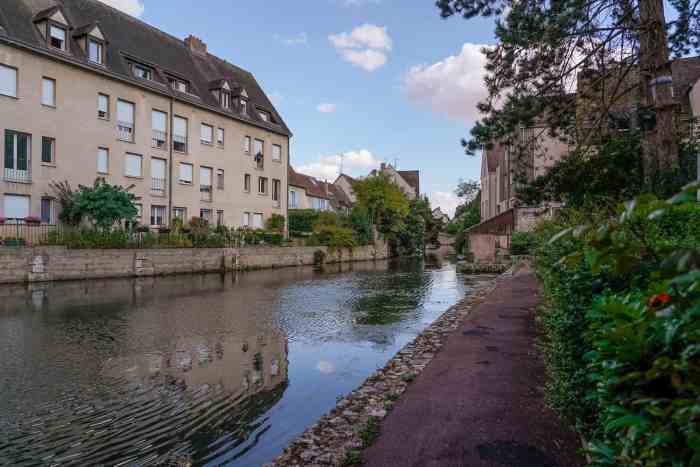
Equally charming are the medieval homes that dot the town – look out for the half-timbered constructions, vernacular house facades with wooden beams criss-crossing white plaster.

All in all, I found Chartres to be very pleasant, clean, quiet and uncrowded (coming from August in Florence!), and it’s given me a desire to return to this part of France for further explorations. Have you been to Chartres? What did you like best about it?
Sign up to receive future blog posts by email
Alexandra Korey
Alexandra Korey aka @arttrav on social media, is a Florence-based writer and digital consultant. Her blog, ArtTrav has been online since 2004.
Related Posts
March 31, 2019
Mantegna and Bellini – Berlin exhibition review
May 1, 2018
Four days in Kyoto, Japan
April 26, 2018

